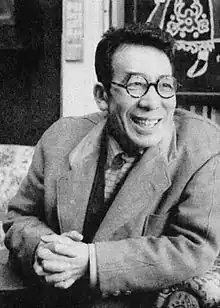
Baku Ishii (Japanese: 石井 漠, December 25, 1886 – January 7, 1962) was a Japanese dancer and choreographer. He was a pioneer of modern dance in Japan.
Career
Aspiring to be a composer, Ishii moved to Tokyo in 1909. Through the introduction of Chiyomatsu Nakamura, he became a student of Kosugi Tengai. While residing in Sosen Mishima's house, he gave up a literary career and became an apprentice member of the Imperial Theatre Orchestra in September 1910. However, the violin the Orchestra loaned to him was pawned by Mishima, so he was fired after two months.
After leaving Mishima's house, he joined the opera club as a student and trained under the name Rinrō Ishii. In February 1912, he had his first role, albeit minor, in Kumano. Tamaki Miura praised his voice. Ishii worked in the Imperial Theatre Opera, but was dismissed after opposing the strict guidance of Giovanni Vittorio Rosi.
With the cooperation of Kōsaku Yamada, Ishii turned to creative butoh, separated from his newlywed wife, and practiced at the Tokyo Philharmonic. From June 1916, he appeared under the stage name Baku Ishii. He started "New Theater" with director Kaoru Osanai and composer Kōsaku Yamada.[1] After teaching at the Takarazuka Revue Company, he worked with Yamada and others to launch the dance and poetry movement, opening up a new frontier in Japanese dance. He also became the first dancer in Japan to choreograph and perform a Western-style work.[2]
In 1922, he traveled with his sister-in-law Konami Ishii to Europe and the United States to study contemporary dance. He became a pioneer of modern dance in Japan. In April 1923, Ishii made his debut as a dancer at the Brüthner Saal in Berlin. Learning from Mary Wigman, he performed in Czechoslovakia, Poland, France, Belgium, and the United States. In 1925, he starred in the German film Ways to Strength and Beauty. He returned to Japan in April of that year. In 1926, Ishii traveled to Korea and performed in Gyeongseong, inspiring the formation of modern dance in the Joseon dynasty from Korean dance. He taught students such as Choi Seung-hee, Cho Taek-won, and Gang Hong-sik.[3]
In 1928, he founded the Baku Ishii Dance Research Institute in Jiyūgaoka.
Personal life
Ishii was born in Akita Prefecture to a family of sake brewers, and his father was a politician.[4] Composer Gorō Ishii is his younger brother. Composers Kan Ishii and Maki Ishii are his sons. Ishii died of thyroiditis on January 7, 1962, in Kanda, Tokyo.
Works
Stage works
- 1942 – Adaptation of Kōtarō Takamura's poem "Book of Geography". Music composed by Goro Ishii. Debuted at the Tokyo Metropolitan Hibiya Public Hall.
- 1948 – "Wandering Group". Music composed by Akira Ifukube. Debuted at the Imperial Theatre.
- 1953 – "Ningen Shaka". Music composed by Akira Ifukube. Debuted at the Tokyo Metropolitan Hibiya Public Hall.
Writing
- The Essence of Dance and Its Creation Method (1927)
- Complete Works of World Music Vol. 30: Butoh Music Collection (1931)
- Ishii Dance and Gymnastics (1932)
- Dance Arts (1933)
- Childrens' Dance (1936)
- Basics and Creation of Dance (1938)
- From Northern China to Central China (1939)
- My Face Essay (1940)
- World Dance Art History (1943)
- Dance Sanmai (1947)
- Dance Expression and Basic Instruction (1951)
- My Life as a Dance (1951)
- Odoru Baka (1955)
Accolades
In 1955, Ishii became the first recipient of the Medal of Honor with Purple Ribbon after the reorganization of the honor system.
- 1950 – Minister of Education Award for "Mystery of the Sphinx"
- 1954 – Art Festival Award (Commendation from the Minister of Education) for "Ningen Shaka"
- 1955 – Medal of Honor with Purple Ribbon
References
- ↑ Omuka, Toshiharu (2004). "Dancing and Performing: Japanese Artists in the Early 1920s at the Dawn of Modern Dance". Experiment. 10: 157–70.
- ↑ Segal, Lewis (March 3, 1988). "Japanese Modern-Dancers to Make U.S. Debut Saturday". Los Angeles Times. p. 7.
- ↑ Lee, Ju-hee (2013). "Reflections on Dance Activities of Ishii Baku, a Japanese Modern Dancer in the Joseon Dynasty". The Korean Journal of Dance Studies. The Korean Society for Dance Studies. 42 (3): 81–98. doi:10.16877/kjds.42.3.201305.81.
- ↑ Yoshida, Yukihiko (2011). "Lee Tsia-oe and Baku Ishii before 1945 - Comparing Origin of Modern Dance in Taiwan and Japan 李彩娥と石井漠". ResearchGate. Retrieved August 24, 2023.
External links
- Baku Ishii at IMDb